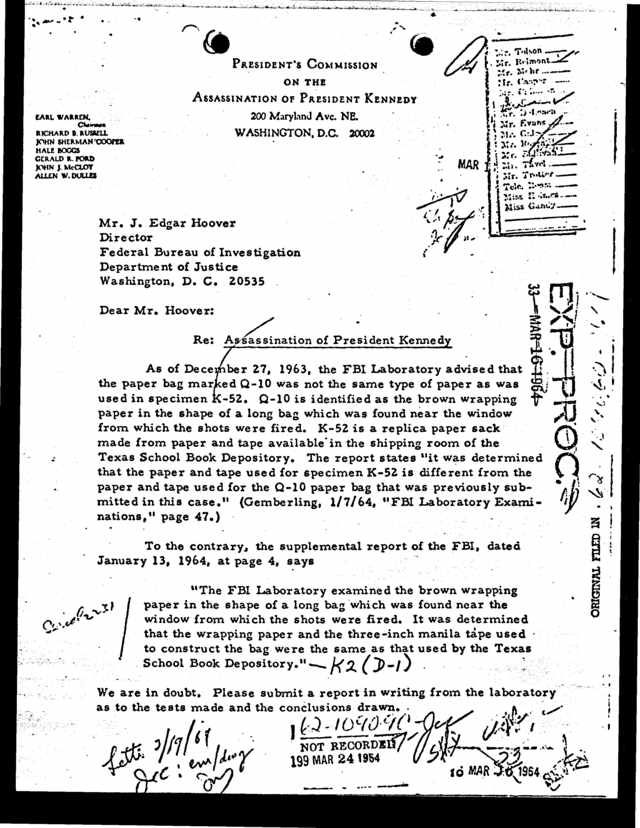
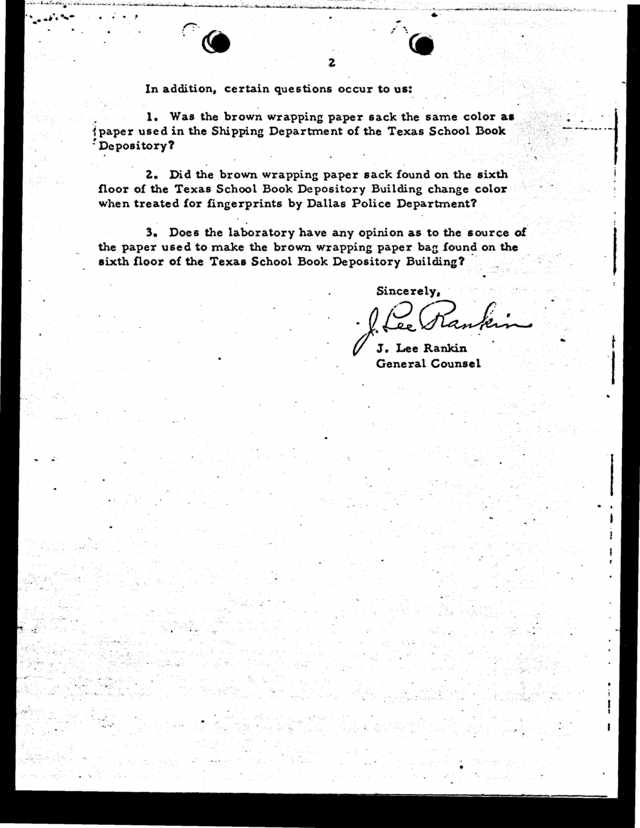
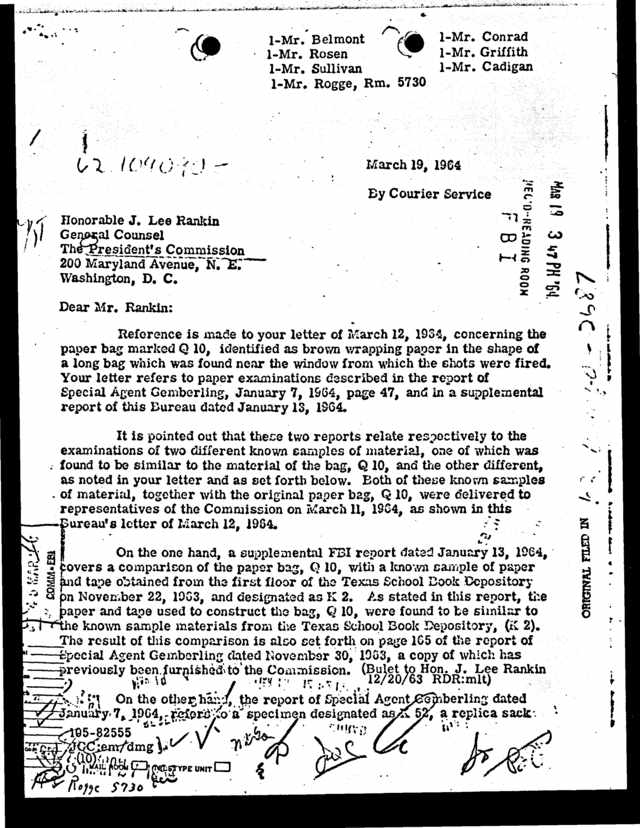
FBI
EVIDENCE TAMPERING
Bugliosi
Was Wrong
Proof the FBI Changed Documents, and Vincent
Bugliosi Was Wrong
by Pat Speer
13 Apr 2009
In 2007, the legendary true crime writer
Vincent Bugliosi released Reclaiming History, a Bible-sized book designed
to answer all the questions regarding a possible conspiracy in the murder of
President John F. Kennedy. Unfortunately, his “answers” provoked more
questions. This short essay examines both the way Bugliosi dealt with one
controversial matter, and the truth about this matter, as recently discovered by
the author.
Although it is not mentioned in the text
itself, on Reclaiming History's accompanying CD-ROM Bugliosi tackles a
particularly troublesome question related to a pair of conflicting FBI reports.
Intriguingly, these reports were written on the finding of a paper bag in the
![on the surface of the fiber the texture of the fiber the felting pattern * * * I found that the paper sack found on the sixth floor * * * and the sample * * * had the
same observable characteristics both under the microscope and all the visual tests that I could conduct The papers I also found were similar in fiber composition therefore in addition to the visual characteristics microscopic and UV [ultra violet] characteristics Mr
Cadigan concluded that the paper and tape from the bag were identical in all respects to the sample paper and tape taken from the Texas School Book Depository shipping room on November 22 1963.192 On December 1 1963 a replica
bag was made from materials found on that date in the shipping room This was done as an investiga tory aid since the original bag had been discolored during various laboratory examinations and could not be used for valid identification
by witnesses.193 Cadigan found that the paper used to make this replica sack had different characteristics from the paper in the origi nal bag.194 The science of paper analysis enabled him to distinguish between different rolls of paper even though
they were produced by the same manufacturer.195 Since the Depository normally used approximately one roll of paper every 3 working days,196 it was not surprising that the replica sack made on December 1 1963 had different characteristics from both the
actual bag and the sample taken on November 22 On the other hand since two rolls could be made from the same batch of paper one cannot estimate when prier to November 22 Oswald made the paper bag However the
complete identity of characteristics between the paper and tape in the bag found on the sixth floor and the paper and tape found in the shipping room of the Depository on Novem ber 22 enabled the Commission to conclude that
the bag was made from these materials The Depository shipping department was on the first floor to which Oswald had access in the normal performance of his duties filling orders 197 Fibers in paper bag matched fibers in blamket..When Paul
M Stombaugh of the FBI Laboratory examined the paper bag he found on the inside a single brown delustered viscose fiber and several light green cotton fibers.193 The blanket in which the rifle was stored was composed of brown and
green cotton viscose and woolen fibers.199 The single brown viscose fiber found in the bag matched some of the brown viscose fibers from the blanket in all observable char acteristics.200 The green cotton fibers found in the paper bag matched
some of the green cotton fibers in the blanket "in all observable micro](images/THE%20ba3.gif)
and
had then used this bag to carry his rifle into the building. But the Commission
had failed to uncover and reveal an important problem with the purported match
between the paper used to create this bag, and the paper then in use in the
building. Bugliosi compounds this mistake. On page 405 of his endnotes, Bugliosi
discusses this problem and offers an explanation:
In a 1980 article in Penn Jones Jr.’s
conspiracy newsletter, Continuing Inquiry, critic Jack White claimed that the
FBI had “sanitized” a document relating to the FBI’s examination of the
paper and tape used to construct the bag found in the Depository, and hence, was
part of the “cover-up” to hide the truth about the assassination. White
reported that two nearly identically worded FBI documents, found by a researcher
at the National Archives, offered two opposite conclusions regarding the source
of the paper Oswald allegedly used to construct the bag. One version stated that
paper samples obtained from the Depository shipping area on November 22 were
found to have the same observable characteristics as the brown paper bag
recovered from the sixth-floor sniper’s nest. A second version said that the
paper samples were found “not to be identical” with the paper gun sack
discovered at the scene of the shooting. (Jack White, “The
Case of Q-10 or the FBI Cover-Up Is in the Bag,” Continuing Inquiry,
February 22, 1980, pp.1–2)
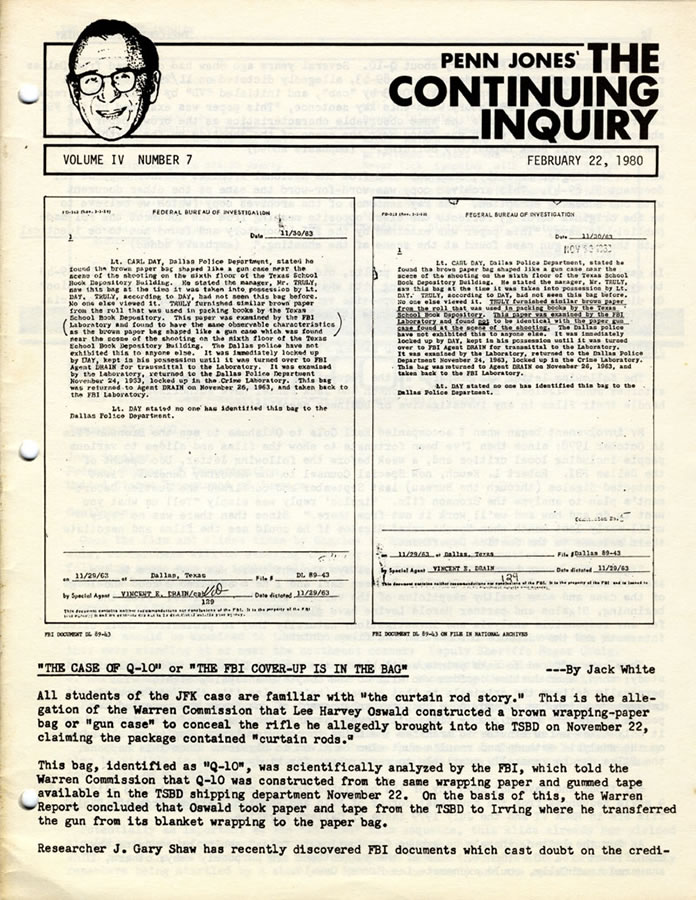
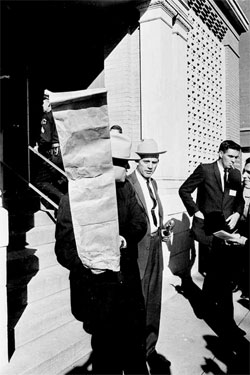
Paper bag being carried from TSBD.
Although White crowed that the documents
“cast doubt on the credibility of the official story,” and his allegations
have subsequently been used by a parade of critics in many conspiracy books,
magazine articles, and Internet postings as “proof ” of the FBI’s
willingness to alter evidence in the Kennedy case, the two documents are no
doubt examples of a misunderstanding that was cleared up by the Warren
Commission in early 1964. In a March 12, 1964, letter,
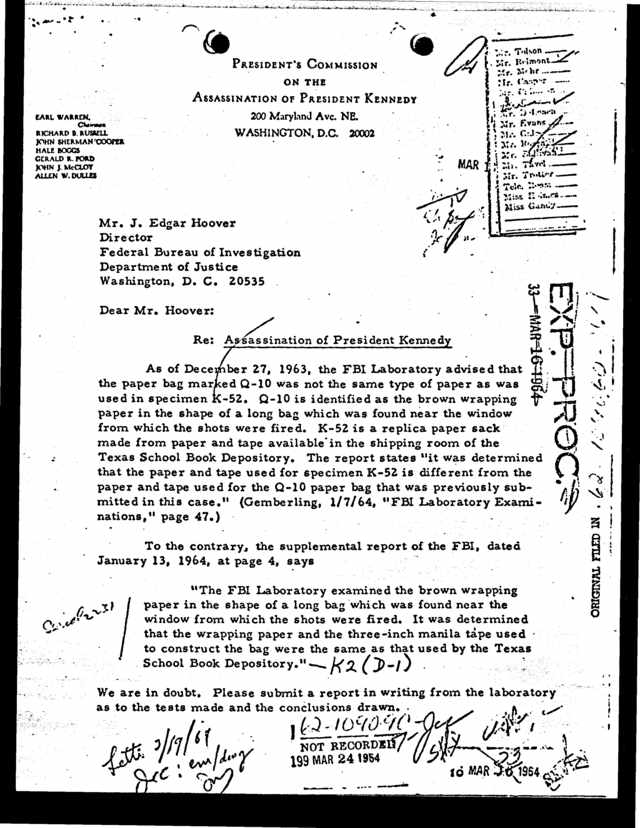
see also FBI Record 124-10022-10200) A week
later, on March 19,
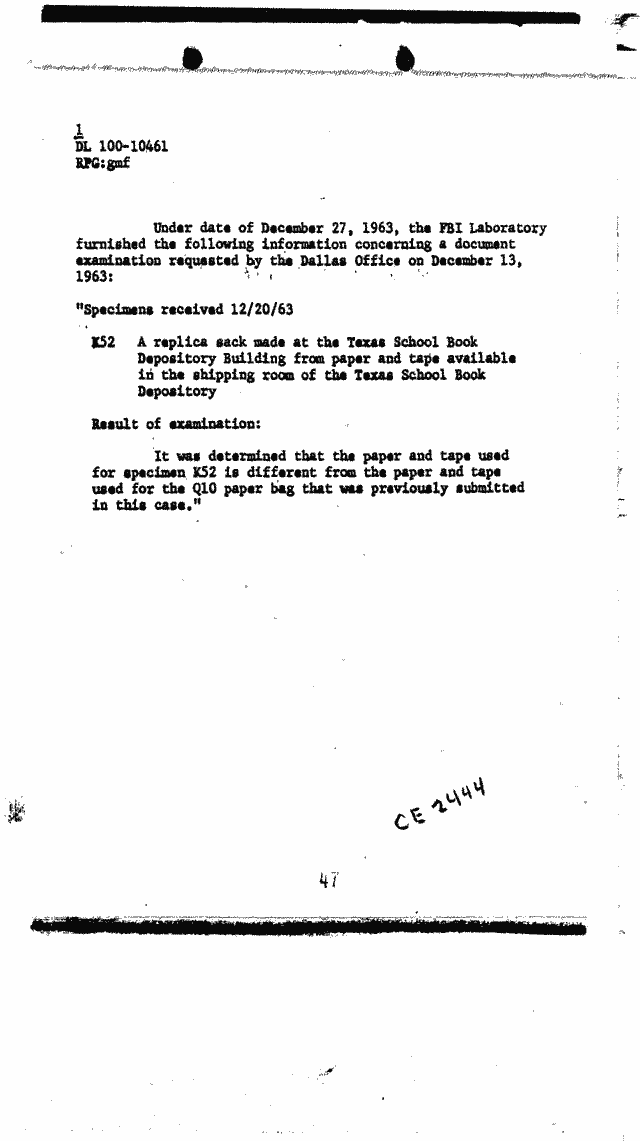
referred to samples obtained from the
Depository on December 1, 1963 (nine days after the assassination). By then, the
shipping department had replaced its roll of wrapping paper with a fresh roll,
since the fall period was its “heavy shipping season.” Consequently, the
samples obtained by the FBI in December did not match the characteristics of the
paper bag found on the day of the shooting. The
second report, dated January 13, 1964,
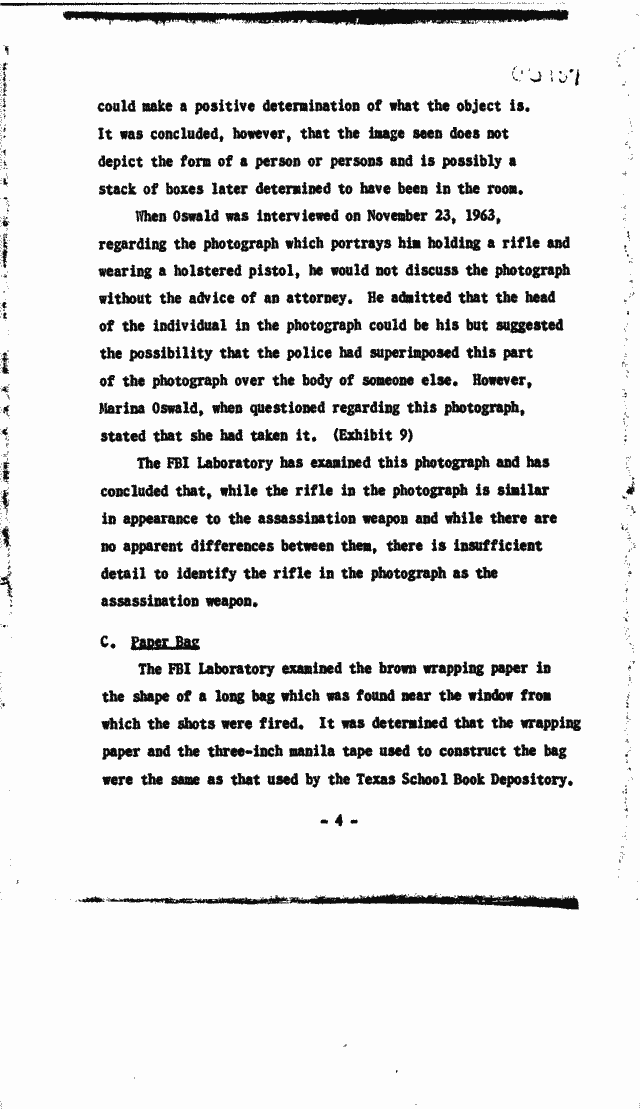
related
to samples taken from the Depository on November 22, the day of the
assassination. These samples were found to be “similar in color to [the bag
recovered from the sixth floor]” and were “similar in appearance under
ultraviolet fluorescence, as well as in microscopic and all other observable
physical characteristics.” However,
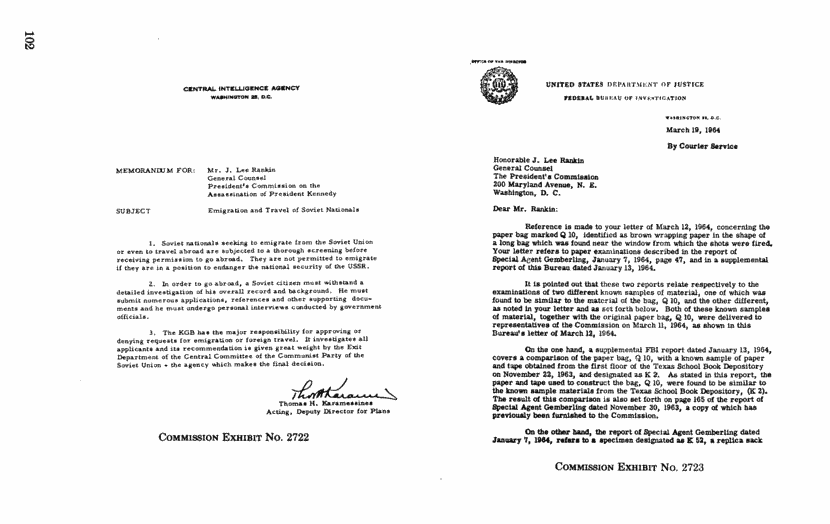
pp.1–2; see also FBI Record
124-10045-10082; CD
897, pp.157–168; CE
1965, 23 H 816)
Bugliosi's explanation is both incredibly deceptive
and incredibly wrong.
This is easy to see, once you know where to
look. The article to which Bugliosi refers is a February 22, 1980 essay on the
probable changing of a document provided the
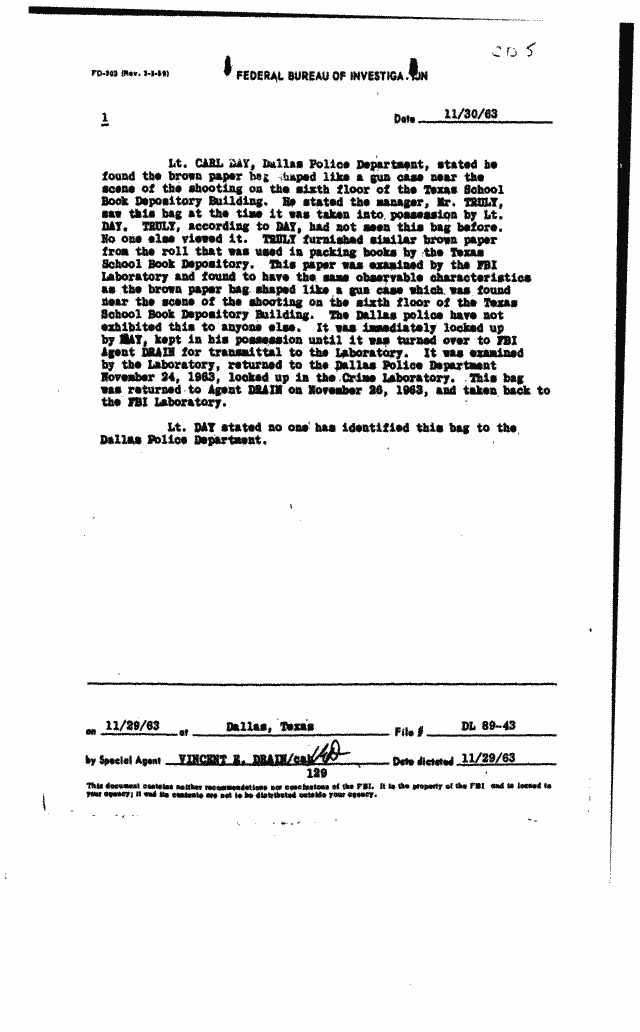
shown
at right). What Bugliosi either fails to notice or fails to tell his readers,
however, is the first thing he should have noticed: the date on the document. As
displayed on the cover
of the 1980 article dismissed by Bugliosi, and therefore presumably read by
Bugliosi, both versions of the document were dictated on 11/29/63. This date is
problematic. By Bugliosi's own account, the paper samples that did not match the
characteristics of the paper bag were obtained on 12-1-63. So...how can a report
refer to the results of a test that has not yet been performed, on an object
that has not yet been procured? It can't. One might venture then that Bugliosi's
"explanation" is little more than smoke, and that he really has no
clue how to refute Jack White's article.
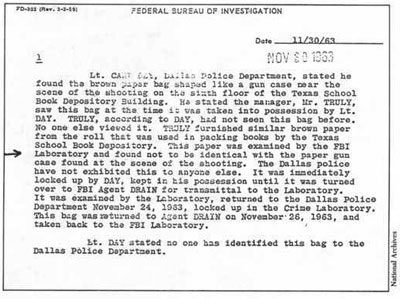
Alternate 11/30/63 FBI report discovered in National Archives by
Gary Shaw, stating that the TSBD-furnished paper was "found
not to be identical with the paper gun case."'
Reprinted in Henry Hurt's "Reasonable Doubt."
But, if so, he's not the first to run from
this issue. Although it's widely presumed the document saying the paper and bag
were not identical was first discovered in 1980, it was actually found years
earlier, and brought to the government's attention at a time when it could
easily have been investigated. Courageously, the discoverer of this document, J.
Gary Shaw, discussed
the document’s existence at a 9-17-77 conference sponsored by the House Select
Committee on Assassinations, and suggested they interview FBI agent Vincent
Drain, the author of the documents.

While the HSCA, sadly, failed to heed Shaw's
request, we can still take comfort that Shaw found some outside interest, and
that a series of researchers were able to ask and answer many of the questions
the HSCA ignored. In 1981, researcher Ed Tatro, inspired by Jack White’s 1980
article on Shaw’s discovery, contacted the FBI seeking an explanation for the
two conflicting documents. The Bureau's initial response explained nothing. In
1984, however, Tatro asked again, and this time received what is as close to an
“official” explanation as we are likely to receive. As recounted by Tatro in
an article
in the January 1985 issue of The Third Decade,
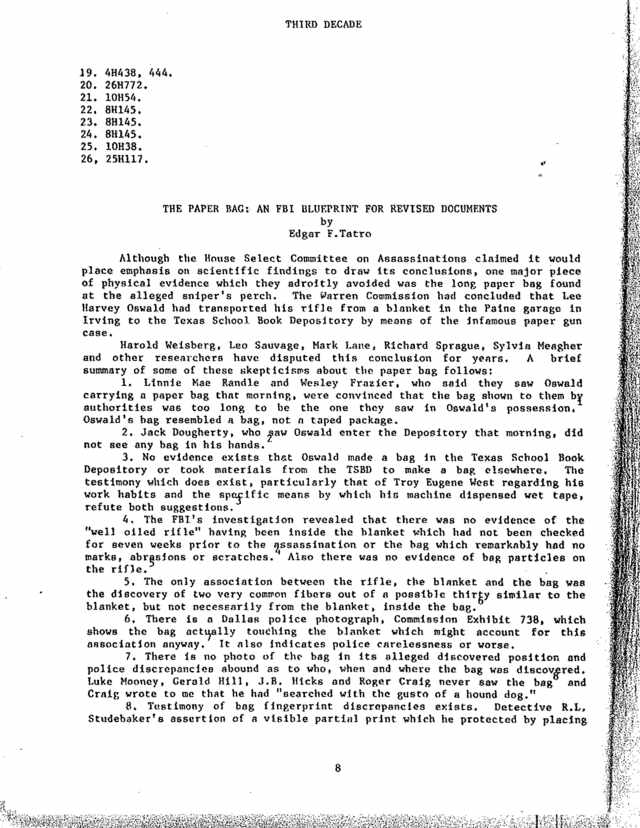
the FBI’s Assistant Director of the Office
of Congressional and Public Affairs, William Baker, offered that the document
discovered by Shaw was found to be “inaccurate” upon review at FBI
headquarters, and that “The Dallas office was instructed to make corrections
at that time.” To the question of how Shaw was able to find an uncorrected
copy in the files, Baker explained further that the FBI sent two copies of the
11-30-63 master report to the Warren Commission, one on 12-20-63 and one three
days later, and that the first copy had the uncorrected copy of page 129 later
discovered by Shaw. As Shaw confirmed to this writer that he found the document
in the
But this explanation also raises some
questions. In 1980, after the appearance of Jack White’s article in The
Continuing Inquiry, journalist Earl Golz asked the supposed author of these
reports, FBI agent Vincent Drain, about the two conflicting reports bearing his
name. Now, if Drain’s words were consistent with Baker’s subsequent
explanation, one might reasonably conclude that the “mystery” surrounding
the conflicting documents had mostly been solved. As reported
by Jerry Rose in the March 1985 issue of The Third Decade,
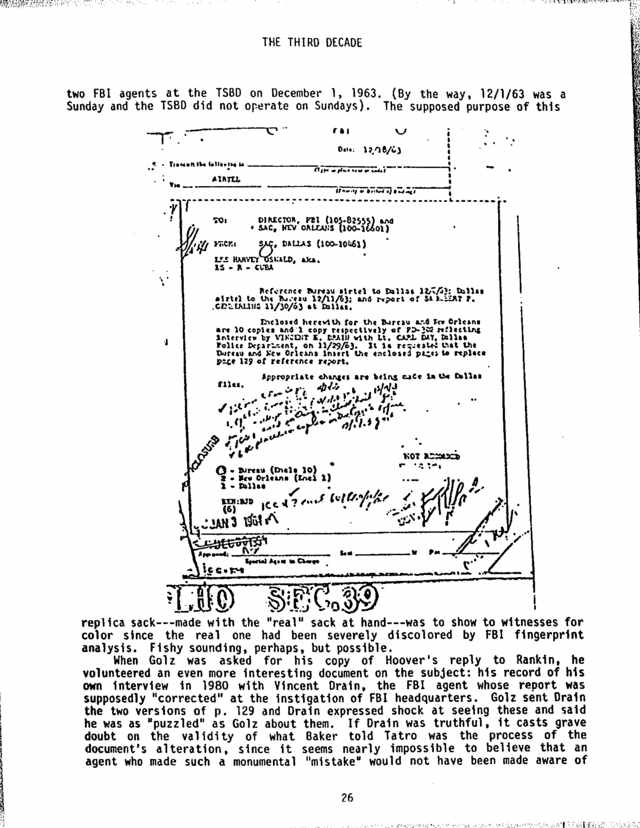
however, Drain’s answers were at odds with
what Baker told Tatro. While Drain, in order to align with Baker’s subsequent
explanation, should have admitted something along the lines of “I screwed up,
and was asked to rewrite my report” he instead “expressed shock at seeing”
the documents and “said he was as ‘puzzled’ as Golz about them.” Even
more problematic, in light of what Baker was to reveal, Drain “expressed
certainty that the copy saying the materials tested were the same was the
original document,” and speculated that the document discovered by Shaw, and
subsequently acknowledged by the FBI’s Assistant Director to be the de facto
original document, was a “fake.”
If Drain, who had no way of knowing what
Baker was to tell Tatro, was deliberately deceiving Golz, he was at least
consistent. In 1984, author Henry Hurt asked Drain about the documents a second
time, and gave him a second chance to admit he’d mistakenly written an
“inaccurate” report, as later claimed by Baker. But Drain once again held
firm. According to Hurt, Drain responded "I am certainly as perplexed as
you are" and then claimed the report saying the paper bag and paper sample
had the same observable characteristics was correct. (p. 98 of Reasonable Doubt,
by Henry Hurt, Henry Holt and Co., 1985). (As a conclusion that the bag and
sample were not identical would have cast doubt on the "official
story" holding that Oswald created the bag at his work, Drain's proposal
that the correct document was the one claiming the bag and sample matched was
not exactly a surprise.)
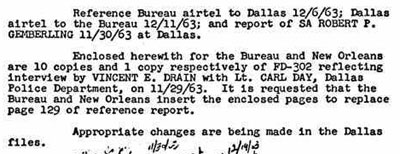
The smoking file: 12-18-63 airtel from Shanklin to HQ.
Click image to view full document page.
Buried deep within the FBI’s files,
however, there was a surprise. In the first
part of Rose’s article in the March 1985 issue of The Third Decade he
revealed that researcher Paul Hoch had uncovered a document demonstrating once
and for all that Drain had indeed originally wrote that the paper sample and bag
were "found not to be identical", and that this had later been changed
upon orders from headquarters. This "smoking gun" document, so to
speak, can be found in FBI
File 105-82555, section 39, page 7. It is a 12-18-63 airtel from the
Should that document have not proved fatal
to Drain’s story, however, two documents subsequently uncovered by Jerry Rose
helped bury it completely. As revealed in the May
1985 issue of The Third Decade, the first of these documents, a 12-6-63
airtel from FBI Director Hoover’s office to Dallas, makes note that
Drain’s report on page 129 of the 11-30-63 Report contains an “inaccurate
statement” and orders the Dallas Special-Agent-in-Charge Shanklin to “handle
corrections.”
![1%Yjwr~..~..ti./ ~ s 1 r ..y r r'.I, ,t',. f~ f 1 .4 / l"' t ''tf 'j a Iy'"s '+tiJV~ ryyi1"dti!CL ~ l ~1 1 01 u 4 1..;.J j ". I 44501
. .~` ~ '" n,.a 7 +., .,6+ 6+^ .L F!~~AM . ! .,~" ,y .4 ,r .K" .V * r "65 yr1' I ",l r, t j'""'M." ~.1 ` ~ .'~'y
~ ~/h"~ I r '":~~ ""r ~',td. ~ { ~t "pub :.,A ~ ,*.f~'.r"'~ . y..h .%1 ".!" (~i ~ ~~ .CCC4 y%^ , \t "1 ~ 1 Iyf~"~ ~~~~~,~~ ~ N~~~;tf~~~~~
'JI '~IA ~V1'~~~ "{ 1t """,."'r,r4~,"I f~"~,~`..I '~i',i~,f Y~'1~., '1rl .'+~~"."i.1"'1f1,,,Pi~;o~;r.. ~1 '",Ij~'~.'~V.!\"l~ ",a"r"r.1"r.~ ",r ~r~~ .fAf " r;'."i .,,y a ~ SK1 M`.'r .e ~ l"~;'t~f':~ _f~ :r '` .r ~. ~7?~I :` " 1 "i
%" ".~4 ~" "~ ~ r c;,~ C . "Ja 7 a h,, 1 (i yfi 1 ty w ~ l'^~ " } .f,r / f r.,,M1 + i ! w..~p
~r "'"R.i r~ ,/~/.1'"~ f;M~ 1 ~ ^ .":"t{.:n,~ 1+ / /'~ " C /~ 711, ~I 1', ~ .tf e"h ,:'':''::,5 r9 c r ~ t3 p w (3) p 13 0 t.,,
w s 0't! g v Co ~s Pet l/ ~ t \r/ t'~ 31'70 a~ l r , (~~,~ I L ) O ."i i 4 p 140 .O
i n r % U M O 11 r1 It p 1;1 01j O k V t O a "p . O O e1 r t+ p W O ~3 W r Lr i
"f t = i` o 'Pf OO f ) ()r..11 ss ~c~ {t'"sc vu csca f t ~ t ti t.. u r..6 ! ;"~".e~ 4 4 ti O A A ~ W n
~~~ "~{ nR f ! e1 ;1 N n .r s O r O 0 W U s ! yt'r t1 r',! E"j ~x L `Y ".."~ F ) Pt) I'b a Id
t4 O 0 U O c c1 r p h A ` 4 q ~1 00 {`, ~r !~~ {III r""'f rN' O L) V ~ l) c I trY U 1+
n I W 41 n O C1 p N y A "".~, h rr ;1 k M W v`/."~ C3 l w/ h"t b i1 y,,.~ ~.r N 1 ",t C~ to W~ ^ p,~ "'~"~'_"p r1
j i~r"j 7 '"1 v;yt ~i 'r N O L rl d t.} n 1111 t1 tt Q w ,~ ) J 't.1 r py GIw e+"r~ c}",.w w trr'4 C 41 t.7
"'moo! O Ci 1 ii V i ~.`a t*O th+ . ~i p '~ 0 to Y.' 3 C C3 t. t) C ( j "0,14.4 1 ct O "tr t.
W O 3 1.1 , k 6 (.r O e4 r3. t , 'i c s r ~ v .. d C1"1 pr c7 U U ...I n y3/ a v N''~
0 C t ] c! W 8 N t, 0 n M .~ Q ter . ,~,. j o t,,s thh t~0 i 't"1 t..4 O( .. o'O O p ~ ar .t 1r'O
"~ `o"'~,.r ,..d ha s%'r3 I.+1 (1 <l r i 1~ V y C ~S 0 O ) O k-s ..R !~ ~r C) iJ W +^r ~,t N t'1 y . t L~
ct d t.c q t'" r rW N j> U G r:~ t* O Cl t""S t+ O t CS 1 c4 q NtJ Oo3 "."r y P3 A
O VM "'+f "1 ,~ tw 4,4 1 h t 171 t+ ch r~ t 'ty o w .~ r ,r O c~ U [~W rs ~4 A * cA O t ...A
` 1.r P & . A t p p ti .k + 1 u i. eh o u O rs w i a cc ~r r """,' ~ ~ w o c) wr'4 "
h I p0 1 pU C~ I'l CZ r oa t+ t{?U C tt 'i~;.r ~ r+m ~ II Q o ",.!,f p G 4 p r ~C C l,~ f '"c f t
! 1 . ~y1+r rr w 4.'w c} a IS'J ci r C5 fie 0 " Y O O O '% UcAOU (~ (~ Wpn ~ p o o c;"~;J Li t~ y :.~ 4
r t 1'w. It~~ Ar:~ 4 oo! , " ~1;;ti 1+.y r""i1:1 N t} r N hL0 ~~ ". '' .>a: O C1 U ~ a + ~7r .i el I 146 r.* w U td c
y N1 1 w N cl Wp t tJ N i h+ P p+ O N 4~ J ~ y i ( M~ (~ . "~ rN f 1 ~"! . "/
r !~ LOl jar tw o f3 U yt+ M i' it r" 14 I I.a &! t+ O ~ 19 $ ..~v r t C'A 4 r O ti C'a *~;""~4 S'I .'1 4'4 r
ati.i V 6,g rtl) oO .t+ El0e'lW f ( ut".tchC/'4;t'~OA + t3Y ;wF . " + OV ~""~ O F1 "~ ~3 1 ()y V r4 a r t ~ ~ f~ et Q U
'El O O p tJ t} u r~ r.1 O rk p O et 0 ) 4 e~s_ . td G! tR = { O iR .~Uh ()'"p`4 (,ap C .1 C "" t~A p O t~t1'A Q (Y.1
s, i "'i ../" r ti 0 3 .~4~ . .r.~ ee 6 1"+"i} r"1 V rM~v3 rj~ "."1;":1 ,.Z v u "" ~ `.:"~~ t.A a h~ rn.. ~""1 tb l) ~ ) r p'd ~ W
,f f I~MM ~~~ % r, """'"'r ~ O FI ' L9 !+"N t~1 1~ L` ` 1 If(t t A c>"w t1 N c p A " o h 0 4 ON IN a
r . 4 i>` w ,r % "1 f , . h ~r+ ~/ "ASS C'i 14 (} .t r t'} (A 1 W Ai 1 "+mac p A i k 1 ~r t~4
} r~ L~ + d t C1 0 1 1 `C O M f u Q O Y ~y .) C G~ t j G~ E7 ~ ~ "IS cP i+t ' .b .~ ` 1 4
O'a V C9 a r ('1 r+ M 1$ 'I c O O ~1 e+ 0 C~ A O o $i -ov ..~ itl ` c m5 p p a P C j r
c'~~~ ~ 1 . ~ A N 'I I O q 1.ow O 'e p= 0 ~'`' t ".j r t 4:1 t~ It :..l ;~',` 4 d !y H 1+ ,4 C ri.cl
r l 0 Q V ~Q ",~ C7 P r r o c a W ti {7 O 0~ tIi ",g f II 4 +" 4! ~V ate g .^!('rs A,'.!y ..5 w ~~ r ci ti t
o .1.M'"~ r1(i ~ `+ '"~;'" "'i i ","Z ,~ r, r } .";., r N O N d t.-. r]. t.. r t U A M p C k ;W 1146 !
# li,. ,' F ~J p n~j.,t ,v + K) ~~.0 o 1.71 ..tJ tr O {"~G t:: d C~( U G C3 ' n t p M a
O !i Q"U (~");~",:"f~"~~ ~(~ Yi t U fit p p i~ A a ,7 ,.r t ~ i .-s' NI p . P 10 Q 0 w r o eL e't .:r, . ,
r. p a Ct hb cr ;y ~ 3 O u M n ~ $11 d f ",".1 .1 1 ."1 ~, ..Y.'.4 (1 .. 0 Ci p h w 1 i~ r , f ri
1+ N t 4 crt tr } tit . } hr1 , } r IO (J 0 y p i p l o t ~~ O C`,2 to O 0 O 61
;to .n v hl t1 "!t'4 t Cl Q ".yam 1 ~~ 1 IL '' t 1i h t r t % q ~ 1.1 'b ., I', .jy~ (I t ~
. ry. r~ t r v ~"l "$' y aat V`k yJ P t ' . ,,i7~"~ Y f 0 .1.0 S t %s ~t . r
~w o br , '! I Q I I+ 1 J IT .~i t '"f Jlh O O+ V "~ "y+I i"r.'~~riM!-y''t M'y ~ ?-40 trey 7~ u ,i , ".~ ~.~") it
y f '~ ".r .~i ~M ~t'4:'j ' I'{ ` ' ~ ~ "~ '/ .,t ! '.w "Ir "'"" ~. y / C fII ~/ ! t "~ .AF ,~"r~T" ~..1 '~ ~Y'~'I
~ti"r~ 1"` "~;r ". 'v! 'r t y I '!'u !'/ r y' S '1 rl '"" " ~t 1 . w lei ri" M A4 ".'~ r'r r y r t . ;1 ,/',r'9
P..f"~ y, r'~ 1l .) CIy';~+ r , j ~."` r aV I ~ "ilk 'r lIj.~''" i. f1''~ ~ti~T I. "j :'i I ,r. tr,j + i / . ,r~ "
'1{M ,"~ r "'y . f ti . t .A y Y 1 r w".! L/ Y :t",f t,~ ,R ;4 I~ +~~1 t I~~ ".\~~ x ~.'~"icy ~,;r}~~ 11/J~ t t
1 vlM %''Ii ^ t ..r4 1r, Ir, I '"/ ~ A "r "~"a,, ,l,/ r :' .1""~r M ."", 1 i"j . ,' ")': t1" ~~1 "'~(tA ,""%i ..](images/THE%20ba15.gif)
The second document, from 12-11-63,
is an airtel from Dallas back to Washington reporting Shanklin’s progress,
and notes that the “necessary actions to correct inaccuracy” are “being
taken.”
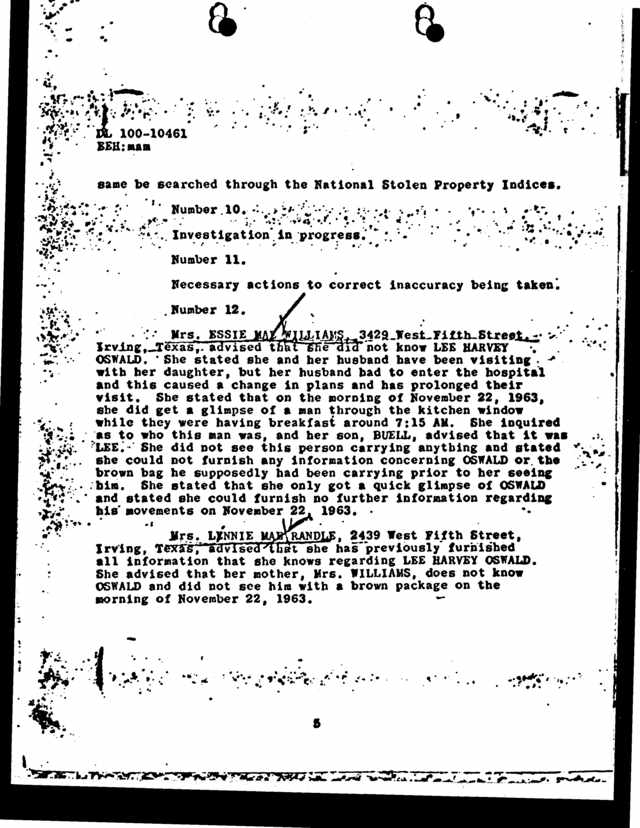
From these documents, then, one can only
conclude that Drain, who’d only escorted the first day evidence from Dallas to
Washington, and then flown it back, had either inaccurately represented the FBI
Laboratory’s findings on an important piece of this evidence, or had
accurately represented the Laboratory’s findings after a decision had been
made not to do so. The former is suggested by reports and testimony claiming
that the paper bag and sample had “the same observable characteristics.” The
latter is suggested by the strange fact that Drain, for what would have to have
been considered a monumental mistake, apparently received no reprimand, and that
Hoover and Shanklin, in their correspondence on the “inaccurate statement”
in Drain’s report, expressed no interest whatsoever on how he came to make
such a statement.
While one could go on from here to discuss
which version of Drain’s report was actually “accurate”, we’ll stop here
instead and focus on the simple, unavoidable fact that the three documents just
cited prove beyond any doubt that the FBI did, at least on occasion, change
reports, even after they had been signed, dated, typed-up, and circulated.
For those studying
As a consequence, we are left to
wonder...did the paper sample have the "same observable
characteristics" as the bag, or were the paper sample and bag "found
not to be identical"?
And, more importantly…what other archive
documents have been re-written weeks or months after the fact, and re-inserted
in the record as if they were the original documents?
We await Bugliosi’s “answer.”
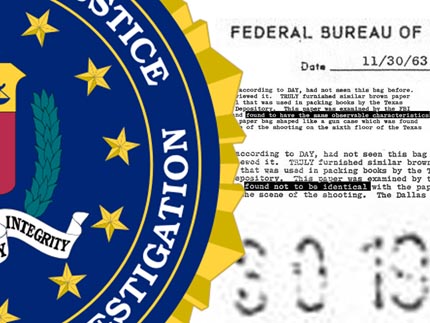 Proof the FBI
Changed Documents
Proof the FBI
Changed Documents
In a new essay entitled Proof
the FBI Changed Documents, and Vincent Bugliosi Was Wrong, Pat
Speer traces the history of an important finding which casts a question mark
over the sanctity of the documentary record in the JFK assassination case.
The focus of the essay is a pair of FBI memos regarding tests made on a
paper bag recovered from the 6th floor of the
But in 1977 researcher Gary Shaw found at the National Archives an almost
identical memo, with the same date, in which tests showed the bag “not to be
identical” with TSBD paper. In this essay, Speer retraces the work of Shaw and
others, and finds the explanation offered by author Vincent Bugliosi to explain
this discrepancy wanting. He also presents an FBI memo directing that all copies
of a report featuring the "not to be identical" memo have that page
replaced with the alternate version; proof that the FBI was not above altering
its own reports after the fact.
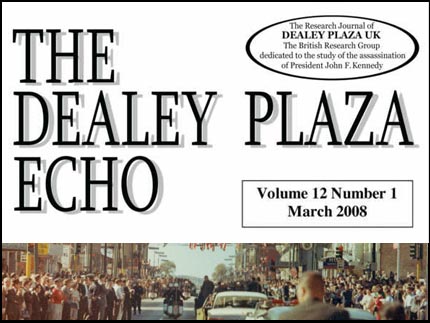 Dealey Plaza Echo -
Volume 12, Issue 1
Dealey Plaza Echo -
Volume 12, Issue 1
The March 2008 issue of Dealey Plaza Echo, the outstanding Kennedy
assassination research journal published by the
This issue, in addition to news and other segments, contains several
original essays:
- The
Single Bullet in Flatland, Part 3, by Alaric Rosman.
- The
Ups and Downs of the TSBD, by Jerry Dealey.
- Gavin
Esler on the "New JFK", by Mark Bridger.
- Lies,
Damned Lies and Elena Garro, by Jim Powell
The Mary Ferrell Foundation has an ongoing agreement with
Contact Information tomnln@cox.net
